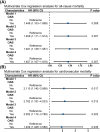Association of overactive bladder with all-cause and cardiovascular mortality in women: A propensity-matched NHANES study
- PMID: 40313594
- PMCID: PMC12040721
- DOI: 10.1002/bco2.70022
Association of overactive bladder with all-cause and cardiovascular mortality in women: A propensity-matched NHANES study
Abstract
Objectives: To examine the impact of overactive bladder (OAB) on all-cause and cardiovascular mortality in women in a real-world setting, and to examine the association of TyG-related indices with OAB.
Methods: Data on 6580 women aged ≥20 years were collected from the National Health and Nutrition Examination Survey (NHANES) database. Kaplan-Meier curves and Cox survival analysis were used to evaluate the association between OAB and all-cause and cardiovascular mortality. Biomarkers for metabolic syndrome were assessed for their association with OAB, including triglyceride-glucose (TyG) and TyG-related indices. The association between TyG-related indices and OAB was evaluated using restricted cubic splines (RCS), receiver operating characteristic (ROC) curves and multivariate logistic regression, with propensity score matching (PSM) employed to balance confounders between OAB and non-OAB groups.
Results: Kaplan-Meier curves showed that OAB was associated with a poorer prognosis, and multivariate Cox regression analyses indicated that OAB was an independent risk factor for both all-cause and cardiovascular mortality. RCS revealed a positive association between TyG-related indices and OAB. Both ROC curves and multivariate logistic regression analysis indicated that TyG-WHtR (TyG combined with waist-to-height ratio) was strongly associated with OAB, with a higher TyG-WHtR associated with an increased risk of OAB. The retrospective design and selection bias may be the potential limitations.
Conclusions: OAB is positively associated with all-cause and cardiovascular mortality in women. TyG-related indices are positively associated with OAB, with TyG-WHtR as the most effective index.
Keywords: all‐cause mortality; cardiovascular mortality; overactive bladder; propensity score matching; triglyceride‐glucose index.
© 2025 The Author(s). BJUI Compass published by John Wiley & Sons Ltd on behalf of BJU International Company.
Conflict of interest statement
We declare no conflicts of interest.
Figures



Similar articles
-
Association between triglyceride glucose-waist height ratio index and overactive bladder: based on NHANES 2005-2018.Front Endocrinol (Lausanne). 2025 Apr 15;16:1541218. doi: 10.3389/fendo.2025.1541218. eCollection 2025. Front Endocrinol (Lausanne). 2025. PMID: 40303634 Free PMC article.
-
Association between triglyceride-glucose related indices with the all-cause and cause-specific mortality among the population with metabolic syndrome.Cardiovasc Diabetol. 2024 Apr 24;23(1):134. doi: 10.1186/s12933-024-02215-0. Cardiovasc Diabetol. 2024. PMID: 38658993 Free PMC article.
-
The U-shape relationship between insulin resistance-related indexes and chronic kidney disease: a retrospective cohort study from National Health and Nutrition Examination Survey 2007-2016.Diabetol Metab Syndr. 2024 Jul 17;16(1):168. doi: 10.1186/s13098-024-01408-7. Diabetol Metab Syndr. 2024. PMID: 39014458 Free PMC article.
-
The association between triglyceride-glucose index and its combination with obesity indicators and cardiovascular disease: NHANES 2003-2018.Cardiovasc Diabetol. 2024 Jan 6;23(1):8. doi: 10.1186/s12933-023-02115-9. Cardiovasc Diabetol. 2024. PMID: 38184598 Free PMC article.
-
Exploring the association between the TyG-WHtR index and the incidence of stroke in the obese population: based on NHANES data from 1998 to 2018.J Stroke Cerebrovasc Dis. 2025 Feb;34(2):108209. doi: 10.1016/j.jstrokecerebrovasdis.2024.108209. Epub 2024 Dec 20. J Stroke Cerebrovasc Dis. 2025. PMID: 39710082
References
-
- Haylen BT, de Ridder D, Freeman RM, Swift SE, Berghmans B, Lee J, et al. An international Urogynecological association (IUGA)/international continence society (ICS) joint report on the terminology for female pelvic floor dysfunction. NeurourolUrodyn. 2010;29(1):4–20. 10.1002/nau.20798 - DOI - PubMed
-
- Irwin D, Milsom I, Hunskaar S, Reilly K, Kopp Z, Herschorn S, et al. Population‐based survey of urinary incontinence, overactive bladder, and other lower urinary tract symptoms in five countries: results of the EPIC study. Eur Urol. 2006;50(6):1306–1314; discussion 14‐5. 10.1016/j.eururo.2006.09.019 - DOI - PubMed
LinkOut - more resources
Full Text Sources
Miscellaneous
